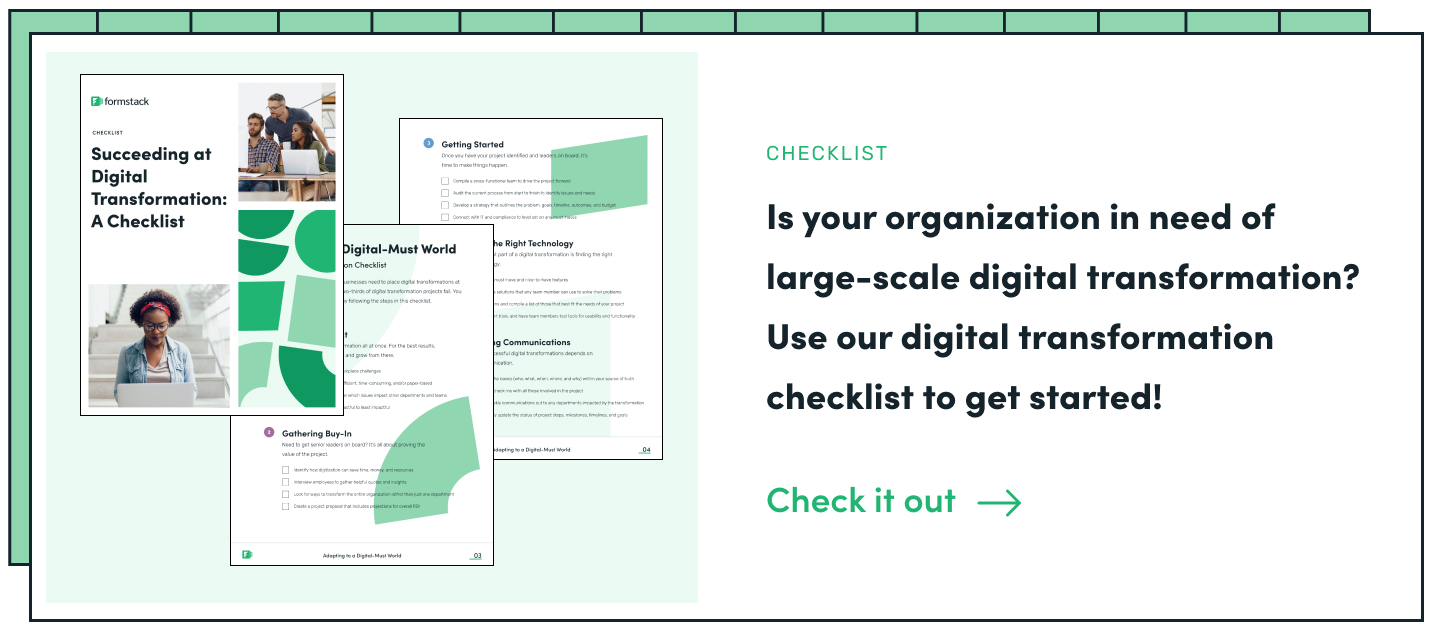You’ve heard about the power of no-code software and want to share its value with your customer base. No-code solutions help businesses save time and money through faster workflow implementations and scalable process adoption.
As a no-code solution, Formstack knows a thing or two about no-code software selection and implementation. We’ve compiled this interactive checklist to help guide implementation partners with best practices as they share the power of no-code solutions with their customers.
#1: Organize Stakeholders
Now that you’re familiar with the benefit of no-code tools, your next step is to spread the word! First, you’re going to need to help your customers share the power of no-code with their team. To gather buy-in from key stakeholders, they’ll need to prove how a new solution will add value to their organization.
Use this section to nail down the budget and identify the organization’s no-code champions, users, and decision-makers.
- Cultivate no-code champions within multiple departments across the organization.
- Create a proposal that projects overall ROI, such as improving the customer support times or supporting inter-departmental data sharing.
- Work with the team members who will be using the no-code software every day after the initial implementation to understand their needs and abilities.
- Coordinate with the person who will be responsible for the final decision to adopt a no-code solution.
- Identify and share how no-code tools can save time, money, and resources for each department.

#2: Identify Needs
Apps and software are crucial to keeping any business running smoothly. But organizations often run into the problem of collecting too many point solutions rather than cultivating an efficient tech stack.
As a consulting partner on a no-code implementation, you should take time to evaluate any technical gaps in the organization to identify the primary problems a new solution would solve.
- Create a list of what workflows are working and what workflows need to be updated or added.
- Consider what a limited tech stack is currently costing the organization. If things aren’t getting done, that cost may be recouped by investing in no-code tools.
- Interview teams in relevant departments to learn where no-code tools would be most beneficial.
- Outline a timeline for software implementation, but remember that no-code software is built to be easy to use and adopt.
- Find ways to use one solution to solve multiple problems. For example, this might include opting for an integrated platform solution over multiple point solutions.
#3: Consider Integrations
The organizations you work with run on software. So you’ll want to choose a solution that integrates with the tools they’re already using.
Here are some things to consider as you identify which tools the business you’re working with needs their no-code solution to accommodate:
- Could data in their CRM or marketing automation software be more effectively used if they were able to easily and quickly connect workflows?
- How well is the data in their priority systems maintained? Could a simple no-code solution help team members keep information up-to-date?
- Would collaboration between teams be more efficient if a no-code solution integrated with a priority solution in another department?
Once you’ve outlined the workflows your customer would like to build or optimize with a no-code solution, take time to make a list of any software they currently use—or would like to use—in these processes.
Related: How to Conduct a Tech Stack Audit for Smoother Operations
#4: Make a List of Must-Haves
No-code and low-code tools come in all shapes and sizes, so take time to consider what’s most important to your customer. Maybe they need a tool that integrates with their CRM or a solution with a dedicated customer support team.
Here’s a list of possible must-haves to help your customers narrow their search:
- Ease of Use
- Integration Options
- Open API for Custom Integrations
- Quality Customer Support
- Access to Professional Services
- Price (Initial Costs vs. Long-Term Costs)
- Ease of Setup
- Scalability
- Customization
- Security and Compliance Requirements
- Reporting and Analytics
- Ongoing Maintenance Requirements
- Agility and Flexibility
#5: Implement Software
Once you’ve walked your customer through the previous steps, it's time to implement the no-code solution! No-code tools are built to be implemented quickly, so you can spend less time generating forms and documents or making basic connections and spend more time designing with CSS or building custom integrations.
- Identify how your customer will measure the success of your no-code software implementation. These key performance indicators might include number of departments adopting the solution, time saved on workflows, reduced volume of IT support tickets, how many workflows are improved with no-code.
- Choose a couple of key workflows to test before rolling out the no-code solution to the entire department or organization.
- After testing, identify best practices for creating new no-code workflows.
- Use the no-code champions to show staff within each department how to quickly spin up new workflows and add to the implementation you’ve built.

#6: Launch Smoothly
A well-executed launch can make or break the adoption of the implementation you’ve spent many hours building for your customer. Before you send your build and no-code solution off to your customer, don’t forget to check a few basic things.
- Test new workflows multiple times.
- Document the entire process from start to finish in simple steps and terms.
- Get users outside the project team to test and provide feedback.
- Designate one person to handle all questions, concerns, and issues.
Empower your customers with no-code
Discover how no-code tools like Formstack make it easy to help your customers digitize processes, save time, and do your best work. Quickly automate the processes that matter most to your customers—securely, in the cloud, and without code.









